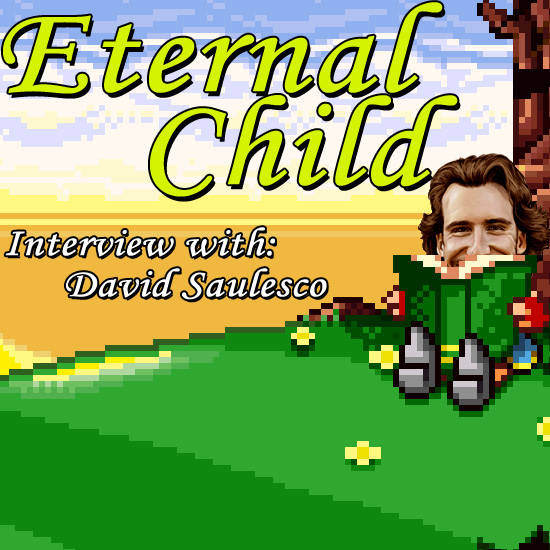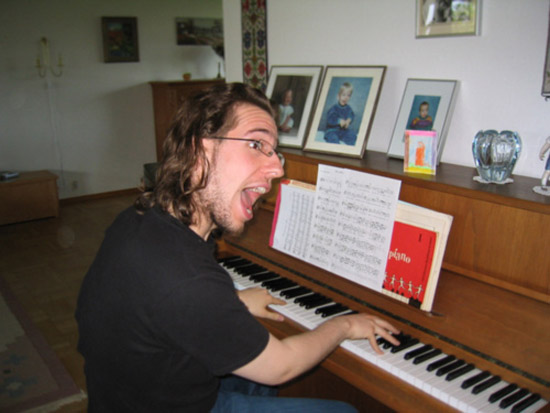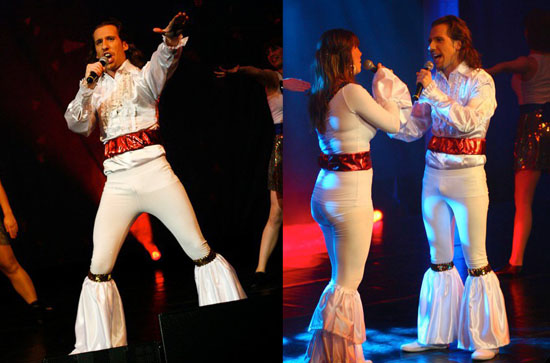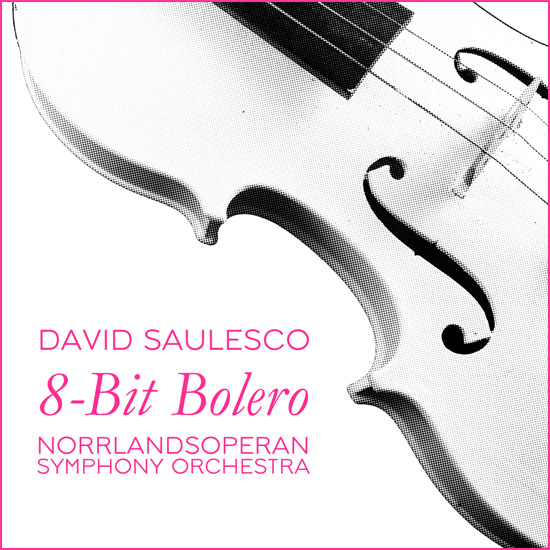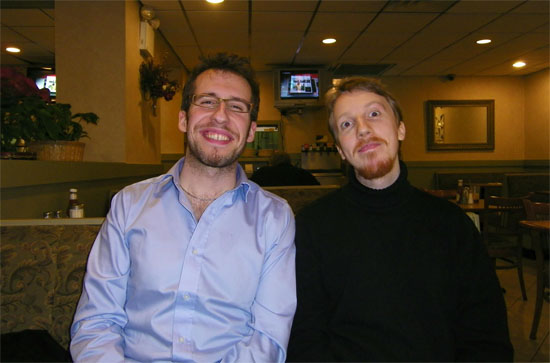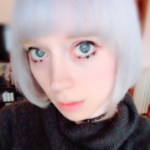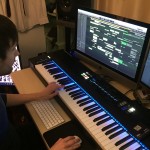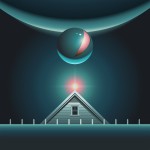Since the summer of 2002, David Saulesco has climbed the ladder of success slowly but surely in his lifelong dream to work with video games and music. It was in that year that the then 16 year old composer was launched to indy fame and recognition with Derek Yu’s freeware masterpiece Eternal Daughter. Since then the young man has thrown himself into nearly all ends of both the music and video game industry, producing, arranging, contracting, he even rode on a horse once.
Now, Saulesco is returning to his proving grounds, and will be releasing the Eternal Daughter 10th Anniversary Original Soundtrack on May 1st. With so many projects behind him and in store in the near future, it seemed only natural to have a chat with the man and speak about his views on composing, video games, symphonic shows and everything in between. Saulesco is never short of his trademark charm, and is of no loss of words on any subject.
Click the jump to read our interview with David Saulesco
OSV: Thanks for being a good sport and talking to me today. And might I say you look very fit and trim. Now initially I had the idea that we would have this talk and offer the results in Norwegian and Swedish, but then I realized that Swedish is so unintelligibly and silly compared to my mother tongue of Norwegian. So let’s just meet in the middle and offer it in plain English.
Today you and I will talk about you returning to one of your past accomplishment for another spin, but before that I want to talk a bit about your background and other projects as well. Let’s start by your upbringing, where are you born and raised?
Saulesco: I was born and raised in a sleepy Stockholm suburb, a stone’s throw south of
the city. It seemed so big when I was a kid, but when I go visit my mom who still lives there I realize it’s actually quite small. When my parents moved there in the early 70’s it was very pretty, very picturesque, but now it’s turning increasingly soulless, I’m sad to say.
OSV: How did video games and music factor into your childhood? Could you tell us a bit
about their individual as well as combined influence on you?
Saulesco: Music was always the most obvious influence on me as a kid, because both my parents worked with music, albeit in different fields. My mother worked as a producer at the Swedish Radio P2, classical radio, and at Rikskonserter/Concerts Sweden. My father was a concertmaster at the Swedish Radio Symphony Orchestra. Some of my earliest memories are of my dad practicing and playing scales, or him and mom (who was also a pianist) playing together.
Also, games were essentially what got me into making music as well. I used to play some of my games up to a point where I really liked the music, turn the volume up, put the Game Boy on the note stand on my parents’ piano and play along. My parents had me take piano lessons for a year or so, but I probably spent much more time teaching myself game songs than practicing in between lessons.
OSV: I’m always a bit fascinated by what kind of modern music has had on composer I meet. Was there any specific artist or band either internationally or domestically that really caught your ears and formed your style later on?
Saulesco: When I was younger I actually didn’t listen to a lot of music on my own, if it wasn’t part of something else, such as a game or a movie. Also, when I read books I liked to have music playing in the background to help immerse myself in whatever was going on.
I also remember reading the novel ”Dragons on the Sea of Night” by Eric van Lustbader back in 1999, imagining one of the book’s pivotal events in my head like a movie and internally composing the soundtrack to that event as I read. Immediately when I finished the book, I went to the computer and wrote that piece down. I still have it, listen to it occasionally and I think it’s probably one of my better pieces from that time.
OSV: When can you first remember in life sitting down to actually write a piece of music?
Saulesco: When my parents bought our first home computer in 1994, I started trying to write down the music from games, as well as TV series and movies, in Cakewalk Home Studio which we got through one of my dad’s old colleagues. When I didn’t know or remember something entirely right, I’d fill it in with whatever I thought would fit. And that’s how I first started writing down my own compositions, as a nine-year-old who spent pretty much all his spare time reading, playing games, watching movies – or making music.
But I was making things up by improvising at the piano even earlier. There are photos of me when I’m maybe three or four years old, making up sequences of triads at the piano. Far from a Swedish Mozart, but that’s probably my earliest aspiration to actual music making.
OSV: Of course, we need to talk about which games you played as well. Do you have any strong memories of video games in your childhood that helped shaped you into the exemplary man you have become?
Saulesco: Definitely. My first game experience was Game & Watch, particularly the dual screen Donkey Kong and The Legend of Zelda ones. But when I got my own Game Boy – the first, gray one with pink buttons – I got hooked on games for real. Playing Super Mario Land, Tetris, Gargoyle’s Quest, Link’s Awakening and other fantastic games was a big part of my childhood.
Playing video and computer games was next to making music (and later also cooking!) my favorite pastime so some games are definitely dear to my heart. For instance, in the ongoing debate whether Final Fantasy VI or Final Fantasy VII is the better game (editor’s note: Such a debate does not exist, Final Fantasy VI is the better game.), I probably have to say VI because of all the mornings I almost missed the bus to school from playing it as long as I possibly could.
Before that, Enix’ brilliant games Actraiser and Soul Blazer captured me because of their wonderful gameplay as well as amazing music (by Yuzo Koshiro and Yukihide Takekawa, respectively). Ironically, what I didn’t know back then is that Soul Blazer is the spiritual sequel to Actraiser, which itself later was succeeded by Illusion of Gaia and Terranigma.
The entire Super Nintendo era is special to me, and out of all the game consoles I own (twelve, to date) my SNES is the one I’d keep if for whatever reason I had to get rid of all the others. The only Sega console I owned growing up was the Game Gear, with the Master System cartridge add-on. Mostly, I played Columns and Wonder Boy: The Dragon’s Trap on it. The Dragon’s Trap was also a brilliant game.
OSV: So was working with video games music and in the video game industry something
you decided early on in your life?
Saulesco: Yeah, the combined influences of (predominantly classical) music and computer and video games sort of led me onto that path early. I used to make my own CDs with music I’d made, printing double-sided inlays and spine cards and cutting and folding them by hand to give away to friends and family.
First time I made my own CD was in 1999. I called the album Tracks of Fantasy and it had 28 tracks, most of them around a minute and a half long, and more than a few of them had overt influences from whatever games I played at the time. A few were even straight up arrangements of various video game tracks.
OSV: Of course, the center of our discussion today is your first video game soundtrack, Eternal Daughter, the video game created by Derek Yu and Jon Perry. First let’s hear how you got in touch with Mr. Yu all the way back in 2001?
Saulesco: Well, I already knew about Derek and Jon and the ”Blackeye Software”
moniker they used for their games. I had tried to make games myself using Klik ’n Play, The Games Factory and Multimedia Fusion, albeit quite unsuccessfully. Being silently involved in that community though led me ultimately to popular Blackeye Software games like “Diabolika” and “Trigger Happy”.
I remember there was a big fuss over a demo for Trigger Happy 2 which, for all intents and purposes, was like a scaled-down two-dimensional Metal Gear Solid. A lot of people, including myself, were disappointed when they announced the project had been canceled but also excited about the ’secret project’ they were focusing on instead.
After showing off singular screenshots and sharing little tidbits about the game, in late 2001 Derek and Jon posted on their website that they’d lost touch with their composer and needed someone else to write music for them! That was the start. I sent them a few tracks of mine, had butterflies in my stomach for a few days until Derek replied that he really liked my music and that I was basically on the team! One of the tracks I sent them even ended up in the finished game; “Trench-Coat”.
OSV: Being only 16 years old at the time, tell us a bit about your workspace and what tools you actually used to create your very first video game soundtrack, as well as the material given to you from Yu and Perry during production?
Saulesco: The only real equipment I had back then was my (or, well, my family’s) computer. I didn’t have any MIDI controllers or other hardware, just a keyboard and mouse for input. Cakewalk Sonar was my DAW, and I used LiveSynth Pro for SoundFont playback.
Way back then most of the samples I had were free stuff found on different websites, but I also bought some decent stuff from Sonic Implants. That was funny, because at the time my parents only had dial-‐up internet and downloading at that time large sample libraries (dozens of megabytes, omg) took an entire night which had my parents quite concerned about the upcoming phone bill.
This also means all the notes were input by hand, clicked in one by one and meticulously edited for velocity, pan, quantization and all that stuff. I had a general idea of how it should sound from sitting at the piano and listening to recordings, but I had literally no formal training or immediate way of playing things into the software.
OSV: Eternal Daughter is a wonderful tribute to the games of our generation’s youth, and the music reflects a pretty wide spectrum of expressions, from personal emotions to a colorful world view. It must have been quite daunting for a young student to take on something so encompassing and broad as this game, no?
Saulesco: Actually, at the time I didn’t think about that at all. I was in my very first
semester of high school and just starting to get to know the world, so I think at the time I was rather naive. It didn’t strike me as a huge undertaking or anything, the only difference was that now I had a purpose to do what I literally did every day anyway.
OSV: The Eternal Daughter soundtrack is also interesting in the way it nods to its inspirations, much like the game itself does. From classical legends such as Bach to contemporary masterminds such as Nobuo Uematsu, there are small allusions to various recognizable pieces through the soundtrack. Was this intentional or did you simply have too many late nights with Red Bull and let your subconscious do the work?
Saulesco: Well, I don’t think Red Bull was around back then, and I know I didn’t spend nearly as many nights up composing back then as I do now. But honestly only a minority of the homages and allusions were entirely conscious. Many of them sneaked in subconsciously and have either been pointed out to me by others or I’ve discovered them myself much later. In fact, the more I realized how much I borrowed from others, the more I felt slightly ashamed because I had no idea they were so many!
OSV: You have stated yourself however that the soundtrack has some technical and
musical shortcomings, as well as the release you had on Bandcamp being incomplete. So finally, that brings us to Eternal Daughter 10th Anniversary Original Soundtrack…
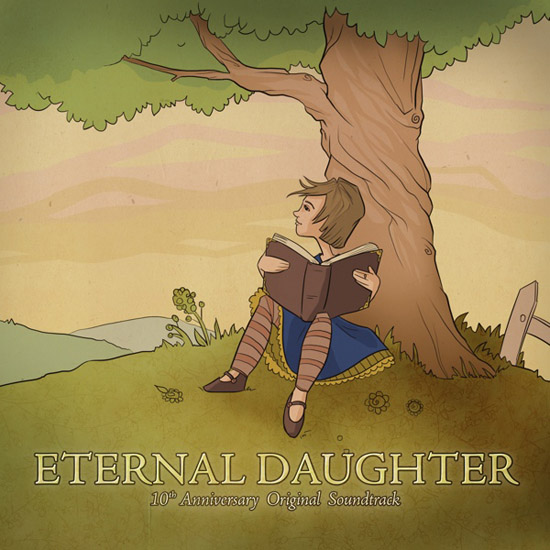
Eternal Daughter 10th Anniversary Original Soundtrack by saulesco
Saulesco: Yes! Unfortunately it’s still as incomplete as the first release, though. The
reason for that is that I wasn’t the only composer for the game. Two other guys also made music for the game; Nick Kraich and Oscar Francis who have two songs each in the game. In all honesty not every piece I wrote is included here either. I purposely omitted the short interlude pieces, like when you find a new item for example.
OSV: I feel so old thinking about it, but it’s 10 years since you composed this soundtrack. How was it to revisit your very first project? What aspects do you personally feel still held up, and which ones didn’t in contrast?
Saulesco: Oh, it’s been immensely fun. And I feel old too, trust me. For a long time I felt like Eternal Daughter was some of my best work overall, in terms of composition and the melodic qualities. That’s what I feel has stood the test of time best; I’m still quite proud of the songs themselves and as a standalone musical narrative I also think the album works really well.
Today of course I have access to much better equipment, both hardware and software, than I had back then. Also, my skills as both a composer, arranger and producer are (thankfully!) much, much more developed now so I feel I can do the music justice today in a way I couldn’t back then.
OSV: I heard you also managed to have our mutual friend surasshu contributing to this
album?
Saulesco: Yes, Steven actually approached me and asked if he could remix a track from the album. I really love and respect his work and I feel fortunate to call him a good friend, so I was really happy when he asked me that. His remix of “Trench-Coat” adds yet another flavor to the album which I’m really happy about. I’ve got so much guitar and string orchestra and fake choirs going on it already, so something completely different feels very refreshing as I think you’ll agree.
OSV: Being 10 years since Eternal Daughter, I am curious to hear your opinions on where video game music in general, both commercial and independently, has gone and how it has changed?
Saulesco: I’d say the biggest change is that the playing field is much more even. Since professional equipment is available to everyone now, commercial and independent game soundtracks can realistically have the same level of polish and production values. I mean, listen to Francisco Cerda’s soundtrack to Jamestown for example. Then there’s people like Jimmy Hinson, Andrew Aversa and Jake Kaufman who are kind of bridging the gap between commercial and independent in different ways.
Also, with ensembles like the Gamer Symphony Orchestra at the University of Maryland,
there’s a very real possibility to have independently produced soundtracks with live orchestral elements, if not now then definitely in the near future. The availability of technology and the ambition of the creators are key factors and the former is definitely there, I’d say, so it boils down to the latter.
OSV: Excellent, so now with fans having a chance to rediscover Eternal Daughter, let’s talk about some of your other projects over the last couple of years.
Saulesco: I’ve actually just started getting back into the video game scene after a pretty long hiatus. After Eternal Daughter I worked with Derek Yu on two other games and also a couple of Blue Tea Games’ early titles, but after that I more or less stopped writing music altogether for a few years. To make a long story short, poopy poo happened and I had to deal with it.
I got back into full swing after I began my college studies at the College Conservatory of Music in Piteå in northern Sweden. Getting to immerse myself in music completely for the first time in my life was what I needed. Moving out of my parents’ house helped too. Most of my college years I spent leaning more toward notated music rather than digital production and I’ve done mostly acoustic pieces, vocal as well as instrumental. I started a male chorus at the college as well and ran it for two years, had my own band, did all sorts of cool things.
Also we have this thing in Sweden called SMASK, which essentially is the Eurovision Song Contest but between our six music colleges instead. I’ve been involved in that in many ways over the past five years; as an artist, songwriter, arranger, orchestra contractor, you name it.
OSV: You’ve been traveling quite a bit the last few years working with choirs. I assume
the choir is something you truly enjoy working with?
Saulesco: Yes, since I’ve been singing in choirs since I was 10. I feel like that’s the ensemble form I’m the most comfortable with and know best. I got to know a youth chorus in Stockholm right before I moved up to Piteå and I’ve been traveling and working with them every year since.
Even more exciting is a fantastic Slovenian vocal ensemble, Perpetuum Jazzile, a 50 person strong group performing pop and rock covers a cappella, in other words without instrumental accompaniment. They have a bass soloist performing the duty of a bassist and a beat boxer who is just incredible. The things he can do with his voice are amazing. I’d like to do a lot more work with different choirs and also conduct more.
OSV: Naturally, we must speak of 8-bit Bolero. Before I speak of it, introduce our readers to this project of yours.
Saulesco: Yes! 8-Bit Bolero is a piece I originally wrote for Josh Whelchel’s Songs for the Cure cancer fundraiser. It’s a chiptune track I made with pxtone, a simple sequencer type program made by the same guy who did Cave Story, Daisuke Amaya. Like the name implies, it’s inspired partially by 80’s game music and also by the orchestra piece “Bolero” by Maurice Ravel.
For my bachelor’s thesis, I arranged 8-Bit Bolero for symphony orchestra and, based on that as well as studies I did, wrote the thesis about the process of arranging old video game music for orchestra. Ironically, Jonne Valtonen, one of the lead arrangers behind the Symphonic video game concert series, later told me he wrote his bachelor’s thesis on the same subject two years earlier!
OSV: Now, can you explain to readers how one goes about arranging a video game music
piece to be performed by an orchestra? For casual listeners the idea might sound like a simple conversion process, but you have experience with preparing these works for orchestras.
Saulesco: Well, what I’m talking about in my thesis is more or less that, depending on
how the original piece of music is written, you can draw upon that when you arrange it. Take for instance Koichi Sugiyama’s music for the Dragon Quest series. Even when you play the 8-bit titles you can hear from the way the music is written that he had a lush, symphonic sound in mind even though he didn’t have the technical capabilities to realize that in the game itself.
Other music, like that from any of the Mega Man games for example, sounds distinctively non-orchestral, so as the arranger you’d have to take greater liberties with the source material than in the case of Dragon Quest, where you could either decide to try and realize the intentions the composer originally had or just do your own thing anyway.
OSV: I in fact remember meeting you shortly after this project was finished, and only having a vague idea of you, my first thought was “why is this man wearing a hat inside?” then as we spoke, I was immensely impressed not only by your sheer excitement for video game music, but also your own creative imagination that allowed for projects such as this one. You have also worked with Gamers X-Mas and arranging video game music for orchestras in Sweden. Tell us a bit about that endeavor.
Saulesco: I’ve done two jobs so far, writing orchestral arrangements for video game concerts. One was for a Norwegian organization called KANDU and one for Orvar Säfström, a video game concert producer here in Sweden. I’d love to do more of that, because it combines video game music with working with live musicians, which I much prefer to sitting in my studio and tweaking sampled instruments for days on end.
OSV: You and I have had the fortune of attending a wide range of video game music
concerts across the world, and also attended a few together, such as LEGENDS and Symphonic Odysseys. What are your own thoughts on how the world of symphonic game music concerts is doing, and your impressions of the shows you attended?
Saulesco: The more game music concerts gain popularity I think a few different types of
concerts are starting to emerge, each going for a different style of arrangement. On one hand there are concerts that put a lot of effort into the whole spectacle with light shows, audience interactivity, big screen movie clips and still images. Even people in costumes dressing up as video game characters.
Opposite to that you have concerts that peel away everything superfluous and focus entirely on the music. No videos, strobe lights or embarrassing costume shows. Also these concerts tend to be more interesting, musically, in the style of arrangements and/or the music selection. You don’t just get force-fed with the same Mario, Zelda and Final Fantasy pieces over and over again.
Then there are the more fan-driven projects, such as Gamers X-Mas. The people behind that particular concert are quite outspoken against concerts like Symphonic Legends because, according to them, the orchestral concerts are leaning too far away from their gaming roots.
Personally, I prefer the type that puts the music front and center and drops everything else. I’ve heard the same dozen or so pieces performed in almost every concert and I don’t care if they are crowd pleasers or not. You don’t have to play “One-Winged Angel”, “Prelude” or “Aerith’s Theme” all the time. There are so many Final Fantasy games with so many pieces of music between them all that it’s almost insulting that so much of it is consistently overlooked. And that’s just one series. What about all the other games with fantastic music that never gets performed?
I’m absolutely thrilled that video game concerts are as popular as they are today, but I wish more producers had the guts to let go of the standard pieces and dare to do more interesting stuff. And if no one else wants to do it, I’ll do it myself.
OSV: What are some of your upcoming projects, be they video game related or not?
Saulesco: Right now, I’m working on music for an upcoming computer game called Me & My Dinosaur 2, I just recently wrote a couple of new arrangements for Perpetuum Jazzile and I’m writing a concerto for string orchestra for the string ensemble at my old college. I’ve got some choral work lined up in the near future as well, and I’m in talks with some game developers as well so we’ll see what happens!
OSV: Well David, it was a pleasure as always, and this won’t be the last time we sit down to talk video game music, I reckon. We should start thinking of producing a concert ourselves together eventually! Thank you so much for your time today.
Saulesco: Actually, let’s start working on that immediately. I have no shortage of ideas,
let me tell you that! But first, please enjoy Eternal Daughter. It’s a true labor of love for me and I hope that shines through. Thank you, Audi! Next time, let’s do this at your place.
Check out David Saulesco’s website and Bandcamp for future updates, and follow him at Twitter @withaknife.
Tags: David Saulesco, Derek Yu, Eternal Daughter, Indie, Interviews, Jonne Valtonen, Symphonic Legends





























